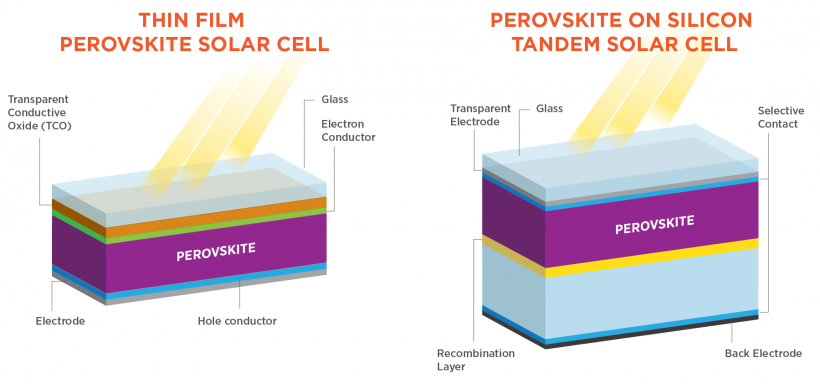Introduction to Perovskite solar cell
Perovskite solar cells are a new innovation in the solar industry, offering higher efficiency, lower manufacturing costs, and unparalleled versatility. Perovskite-inspired cells efficiently convert sunlight to electricity with a crystalline structure. Inexpensive and easy to manufacture, their efficiency has surged from 3.8% in 2009 to 25.7% in 2021 for single-junction designs and 29.8% for silicon-based tandem cells. Despite challenges such as short- and long-term stability, perovskite-based technology holds potential for rapid terawatt-scale solar deployment.
NREL has made significant technical contributions to perovskite research, supported by short-term laboratory-directed research and development funding and early investments from the Department of Energy’s Office of Science, Office of Basic Energy Sciences, Solar Photochemistry Program, and photovoltaics (PV) programs.

What Are Perovskite Solar Cells?
Perovskites are a class of materials with a unique structure that exhibits properties like superconductivity and magnetoresistance. Future solar cells will likely use these materials for their low cost, efficiency, and potential applications in next-gen electric vehicle batteries, sensors, and lasers. Third-generation PV technologies like DSSC, OPV, QD PV, and perovskite PV are pushing past current efficiency and performance limits.
Perovskite solar cells use a hybrid lead or tin halide compound as the active layer, offering low production costs, easy manufacturing, and high efficiency. The active layer in perovskite solar cells utilizes a hybrid lead or tin halide compound, which enables low production costs, easy manufacturing, and high efficiency. Perovskite solar cells are renowned for their broad absorption spectrum, rapid charge separation, long electron and hole transport distance, and extended carrier separation lifetime, thereby making them a promising option for low-cost solar energy production.
What are the elements of perovskite solar cells?
- Perovskite Material: A thin film of organic-inorganic hybrid perovskite materials typically makes up the active layer of a perovskite solar cell.
- These materials exhibit exceptional light-absorption properties and can efficiently convert photons from sunlight into electrical charges.
- Electron Transport Layer (ETL): Beneath the perovskite layer lies an electron transport layer, which helps facilitate the movement of electrons generated by the absorption of sunlight. Common materials used in the ETL include titanium dioxide (TiO2) or tin oxide (SnO2).
- Hole Transport Layer (HTL): On the other side of the perovskite layer is a hole transport layer, which assists in transporting the positively charged “holes” created when electrons are excited by sunlight. Organic materials such as Spiro-OMeTAD (2,2′,7,7′-tetrakis(N,N-di-p-methoxyphenylamine)9,9′-spirobifluorene) are often used as HTLs.
- Electrodes: Typically, materials such as gold, silver, or transparent conductive oxides are used to create electrodes at both the top and bottom of the device. These electrodes collect the generated electrons and holes, transferring them to an external circuit for use.
Working Principle:
When sunlight strikes the perovskite layer of the solar cell, it excites electrons within the material, creating electron-hole pairs. Charge carriers in perovskite solar cells are separated by the device’s electric field, with electrons moving to the electron transport layer and holes to the hole transport layer. This process generates electric current for powering devices or storing energy in batteries.
Advantages or Efficiency of Perovskite Solar Cells
Perovskite solar cells are low-cost, high-efficiency, thin, lightweight, and flexible solar modules with a high absorption coefficient. These cells are used in low-power wireless electronics for ambient-powered Internet of Things applications and may help mitigate climate change. They possess optoelectrical properties such as small exciton binding energy, long diffusion distance, and high diffusivity, which increase power efficiency. Perovskite solar cells offer several advantages over traditional silicon-based solar cells, including high efficiency, low-cost manufacturing, versatility, rapid progress and innovation, lightweight and flexible substrates, tandem cell potential, and a relatively short energy payback time.
Utilizing cost-effective solution-based methods like spin-coating, inkjet printing, or spray coating, perovskite solar cells are easily customizable for various light wavelengths. This dynamic field encourages collaboration among scientists, engineers, and industry stakeholders, aiming to enhance efficiency, stability, and scalability continually.
Overall, perovskite solar cells, with their high efficiency, low-cost manufacturing, versatility, and ongoing innovation, are promising for widespread renewable energy adoption but require further research for stability, durability, and commercial scalability.

Perovskite Solar Cells: Applications and Potential Impact
Perovskite solar cells can integrate into traditional rooftop solar panels for cost-effective and efficient electricity generation in rooftop solar installations
- Their lightweight and flexible nature makes them suitable for various roofing materials and designs.
- Building-Integrated Photovoltaics (BIPV) Perovskite solar cells can directly incorporate into building materials for energy-efficient structures.
- This reduces reliance on traditional grid-connected electricity sources.
- Portable electronics & wearables Perovskite solar cells are ideal for powering portable electronic devices, extending battery life, and reducing the need for frequent recharging.
- Off-Grid and Remote Applications Perovskite solar cells can power essential services in underserved communities.
- You can equip vehicles with Perovskite solar cells to supplement onboard power systems and extend driving range.
- Emerging markets & developing countries Perovskite solar cells can accelerate the adoption of renewable energy technologies in emerging markets and developing countries.
- Research and development Perovskite solar cells serve as a platform for research into materials science, photophysics, and device engineering.
Future Outlook and Challenges of Perovskite Solar Cells
Future Outlook:
- Continued research and development to enhance efficiency and stability.
- Commercialization and scale-up of production processes.
- Potential for tandem solar cells, combining perovskite materials with other photovoltaic technologies.
- Addressing stability and durability challenges.
- Diversification of applications beyond traditional photovoltaic installations.
Challenges:
- Stability and degradation of perovskite materials.
- Lead toxicity concerns due to the many perovskite formulations.
- Scalability and manufacturing costs.
- Regulatory and standard compliance.
- Market competition from established and emerging technologies.
Overall, the future outlook is promising, with ongoing research and development driving progress towards commercialization.



[…] production processes, as well as to increase the cost and efficiency of solar panels. For instance, perovskite solar cells have a lot of promise to outperform conventional silicon-based solar cells in terms of efficiency. […]
[…] is paramount during solar panel maintenance, as working with electricity and accessing rooftops can pose risks. Adherence to safety […]